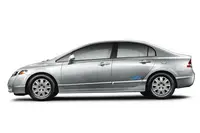Honda Civic GX Tops Greenest Car List ... Unfortunately it's Virtually Unavailable to Buy
Ironic Results name the Chevy Volt 12th on list while making an unavailable car #1
By Marc J. Rauch
Exec. Vice President/Co-Publisher
THE AUTO CHANNEL
 |
Just how screwed up are our national aspirations to become energy independent? You need look no further than the results of the latest report issued by the American Council for an Energy-Efficient Economy. In their 14th annual environmental rating of new cars, ACEEE has again named the Honda Civic GX at its number one "greenest car."
"What's the Honda Civic GX?," you ask. Is it electric, a hybrid, steam-powered? No, it's Honda's compressed natural gas version of its very popular Civic, and this is the 8th time that the Civic GX has been named as their choice for greenest car. The GX beat out the Chevrolet Volt, which placed 12th on the list; the Nissan Leaf; all of the well known hybrids; all diesels; Mercedes' Smart Fortwo; the Ford Fiesta SFE (Super Fuel Economy) and the Chevrolet Cruze Eco.
But here's the killer: the Honda Civic GX is practically unavailable for purchase owing to the fact that Honda's production of new GXs is so small that it makes the minuscule Volt and Leaf production look downright bounteous. So while there's at least one carmaker that still knows how to manufacture a CNG-powered vehicle right here in America, you can't really buy one. And, if you could, you might have a terrible time finding the domestically produced CNG fuel that the GX needs to run on. And it's all because of the bribes paid by the petroleum oil and gasoline industry to our politicians and media-influencers to keep us addicted to gasoline.
THAT'S HOW SCREWED UP THINGS ARE!
Latest Technologies Place But Don't Win In This Year's Greenest Vehicles List
Washington, D.C. — With the arrival of the first widely available plug-in vehicles, model year 2011 boasts the most diverse car offerings ever in terms of technologies and fuels. The American Council for an Energy-Efficient Economy released its 14th annual environmental ratings for the model year showing how they all stack up. The result? Some newcomers — including an electric vehicle and a plug-in electric hybrid — did well, while several of the regulars held their ground.
This year’s ratings reveal a face-off among plug-ins, gasoline hybrids, diesels, natural gas vehicles, and ever-improving “conventional” gasoline vehicles. For the 8th year, the Honda Civic GX wins top honors, notwithstanding changes to Green BookŪ rating methods that boosted other technologies. But below the top spot, the “Greenest” list sees a shake-up: the all-electric Nissan Leaf places second, followed by the gasoline-powered Smart Fortwo. Hybrids take the next three spots, followed closely by Ford’s new Fiesta SFE (Super Fuel Economy) and the Chevrolet Cruze Eco. Also notable on this year’s list is the Hyundai Elantra, with a 4 mile-per-gallon jump in fuel economy over the 2010 model. Rounding out the “Greenest” are the Mazda 2 and the much-touted Chevrolet Volt “extended-range EV,” which slip into the 12th and 13th spots. All told, six new models pushed out entries on last year’s list.
The strong showing of conventional vehicles in the top twelve is a testament to how serious manufacturers have gotten about recasting these vehicles as fuel-sippers with transmission refinements, weight savings, and sophisticated internal combustion engines. “We’re seeing an increasing number of highly efficient gasoline options from both foreign and domestic automakers along with the first electric vehicles. Ford introduced the Fiesta this year and Chevrolet debuted the Cruze, both of which do exceedingly well in our ratings,” said ACEEE vehicle analyst Shruti Vaidyanathan.
Regarding plug-in vehicles, ACEEE Transportation Director Therese Langer noted: “Vehicles running on electricity emit nothing from the tailpipe, but their ‘upstream’ emissions can be substantial, depending on where they’re charged. As U.S. power generation becomes cleaner, these vehicles’ scores will rise.”
The Green BookŪ methodology update also incorporates emissions associated with battery manufacture and disposal in a manner that reflects material content, drawing from Argonne National Lab’s GREET model. Hybrids lose a couple of points on their Green Scores as a result and this year capture only three of the top 12 spots. Once again diesels fall just short of the Greenest list.



